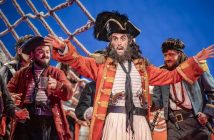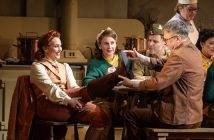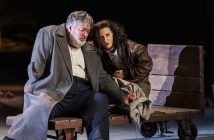Mascagni’s Cavalleria Rusticana and Leoncavallo’s I Pagliacci – the most famous opera double act there is. Cav and Pag. Never the other way round and hardly ever one without the other. On the face of it, it’s clear to see why. They share a style, a period and pretty much the same subject matter. But in reality they’re very different beasts, something that’s very evident in The Royal Opera’s current production.
I know both operas from recordings but had never seen either staged before, so the first surprise was just how long Cavalleria Rusticana takes to get going. Despite some genuinely lovely music, nothing much happens in the first ten minutes which, in an opera with a running time of 70 minutes, is a fair chunk of time. There’s some general scene setting, and the assembled chorus tell us how happy they are they’ve finished work for the day, but that’s about it.

Cavalleria Rusticana
The second surprise was just how flimsy the drama feels. The dramatic weakness in Cavelleria Rusticana (and I say ‘dramatic weakness’ because the music is glorious) goes deeper than the opening few minutes. It’s about what happens onstage or, rather, what doesn’t. The entire plot feels like it happens elsewhere. Turiddu loves Lola, pops off to war, comes back to find her married and turns instead to Santuzza. This has all happened before the piece even starts. Half of what follows is people filling us in on his subsequent infidelity and the fallout from it, most of which we don’t see. Of course, the general reportage is set to glorious music and sung brilliantly. It’s just all a bit on one (admittedly supercharged) level. The feeling you’re left with is of having been told a story with overwhelming passion, rather than living through something with the characters.
One swift interval later and it’s a different story. Pagliacci, with its play-within-a-play, is entirely about the tension between what happens on and off stage, and the drama created sweeps everything along as a result. Yes we have the same story of infidelity, jealousy and murder, but there’s tenderness, comedy and genuine insight into the characters. We don’t just hear about Nedda’s infidelity, we feel her struggle – both in her own jealousy of the freedom of the birds she sees and in her agonising over leaving Canio. We see the specific point she decides to finally leave. This is real life in all its complexity, despite being told through a formal theatrical device. I Pagliacci doesn’t just tell a story, it immerses us in it. It’s a fully realised dramatic experience.

Simon Keenlyside as Tonio, Bryan Hymel as Canio and Carmen Giannattasio as Nedda in I Pagliacci
Given the reaction in the theatre, however, I suspect most people would disagree with me. Both operas got the reception you’d expect from a crowd pleaser sung, and played, extremely well. It’s hard to argue with that really. American tenor Bryn Hymel has a thrilling voice and deploys it to great effect in both pieces; Simon Keenlyside is, as ever, utterly engaging and compelling and the Royal Opera’s Chorus is in wonderful voice. Plus, of course, both operas contain some of the best-loved tunes ever to come out of Italy. But ultimately it’s Pagliacci’s light and shade, rather than the brute force of Cavalleria Rusticana, that makes the evening special.
So, an evening of two halves. Cav impresses and thrills, but Pag delivers the knockout blow. In many ways the slow burn and build of Puccini’s Il Tabarro would make a far better companion piece for it – Tab and Pag anyone?
Cavalleria Rusticana and I Pagliacci at the Royal Opera House until 13th January 2018. Production images by Catherine Ashmore. For more information and tickets please visit the website.




